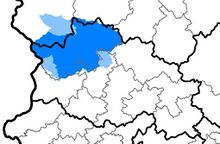Aldzinian language
| Aldzinian | |
|---|---|
| Ѓакка̄ Алженщох Ģakhā Alženśoh | |
| Native to | Gabrielland |
| Region | North Gabrielland Region |
| Ethnicity | Aldzinians |
Native speakers | 600,0000 (2020) |
Gabrielt
| |
| Govoric alphabet | |
| Official status | |
Official language in | Aldzina province |
| Language codes | |
| ISO 639-1 | al |
| ISO 639-2 | ald |
| ISO 639-3 | – |
 Distribution of Aldzinian speakers in the North Gabrielland region Majority language (>50%) Minority language (>20%) | |
The Aldzinian language (Standard Gabrielt: មដឣល្ឌិនន "Mada Aldzinan", IPA: /mada alˈd͡zinan/ Aldzinian: Ѓакка̄ Алженщох "Ģakhā Alženśoh", IPA: /ˈɟakʰaː ˈalʒenɕɔh/) is a Tazbakan language primarily spoken in the Aldzina province located within the Northern Gabrielland region, spoken primarily by the Aldzinian people, but also by other people groups residing in or surrounding Aldzina. Speakers also exist in the neighboring Adinnyan region, primarily in the Dzakramila and the Meladza provinces. Within the Northern Gabrielland region, it is also spoken in the neighboring provinces of Ortom, Edzuli, and Altrang. According to the latest 2020 Gabrielt census, around 600,000 people collectively speak the Aldzinian language. It is the only surviving member of the West Herogyan branch of the Tazbakan languages, and is not mutually intelligible with the other Tazbakan languages, let alone the other Gabrielt languages in general. It is also the westernmost and northernmost Tazbakan language.
Aldzinian is of particular interest to linguists and grammarians alike as the language has arguably preserved the most features and inflectional patterns from Proto-Gabrielt. Aldzinian, as a Tazbakan language, did not descend from Literary Gabrielt, and split off earlier from the Proto-Gabrielt languages compared to the other branches of the Gabrielt language, which was by then still a singular language with burgeoning dialects. With its archaic sentence formation, inflectional morphology, and native vocabulary, Aldzinian is one of the hardest languages to understand in general by other Gabrielt speakers without prior knowledge of the language, whereas in other circumstances similar-sounding words or phrases might hint at a general meaning being conveyed. Much later in the language's development, Kento-Polyash languages began to influence the language to some extent, leaving many couplets of words and resulting in a rich and varied vocabulary.
The language is an official language in the Aldzina province, and is the language of education, media, government, and administration. While the Aldzinian language possesses several notable dialect groups, they are still very intelligible to speakers of other dialects, and are not considered separate langauges. Although so, the eastern dialects which retain more native-words serve as the de-facto official standard used in schools, offices, and government institutions. The Aldzinian language council serves as the language's regulatory body, and oversees the language's development and exposure. Services in Aldzinian are available in the southern portions of the Dzakramila province, where sizeable minorities of speakers live. Outside of the traditional Aldzinian homelands, very few, if any, Gabrielts speak the language, and speakers usually switch to Standard Gabrielt to facillitate communication.
Currently, Aldzinian is written in a modified Govoric alphabet, introduced by the Kento-Polyashi traders in the early 20th century. It is one of the few languages in Gabrielland written in the Govoric script, and one of three languages written in Govoric within the Gabrielt language family. Proposals and calls to transition to the latin script or a native-built script have been raised, however have been stagnant.